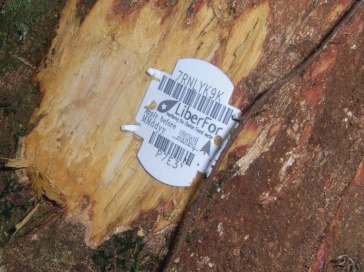Bar Code an Entire Forest to save trees –Very green!

The bar code is the ultimate symbol of commercialism in the modern world. We see bar codes everywhere and on everything in our daily lives. We never think of consumerism and environmentalism as walking hand-in-hand.
In a recently-signed deal between Liberia and the European Union that is what is precisely happening. Liberia is using a cutting-edge bar code system to regulate the timber trade. The European Union is Liberia’s largest market for timber. The technology ensures that only legal timber will enter the European Union from Liberia, a country that houses nearly two-thirds of West Africa's rainforests. Liberia’s forests cover more than 4 million hectares. They are home to the world’s only known viable population of pygmy hippos, as well as such indigenous wildlife as the Liberian mongoose, the Diana monkey, and the small antelope known as Jentink’s duiker, which is the rarest duiker in the world.
Helveta, a British company that specializes in timber supply chain management, has created the tracking system. The inventors at Helveta call it “the world’s most advanced nationwide verification system for wood products.” Every tree in a commercially logged forest is labeled with a unique bar code, it records when the tree is cut down and tags each log cut, allowing ports to track each piece of timber and confirm a legal harvest. Liberia has complete tracking from the standing tree in the ground to finished product for export, right across the supply chain. Every log that turns up at a port has to be traceable back to a stump in a forest. Barcode.com asked Simon Bates from Helveta about the strangeness of bar coding an entire forest, and some of the challenges involved.
“Bar coding a forest may seem strange, but not to us, it’s our job! And, interestingly, it wasn’t strange to local population either, as they’ve always used ways to identify the forest. The only difference is we’re using secure, high-tech methods instead of paint and clay. That’s not to say there weren’t aspects of the project they did find strange, for example, the fact that we use randomly generated numbers, as a security measure to prevent fraud, rather than sequential numbers in the tags. We also don’t barcode millions of hectares of forest in all one go; it is broken down into manageable areas that are tagged as required.”
“There are a number of challenges when it comes to bar coding trees, as you’d imagine. Most of them involve the trees themselves – the barcodes are on plastic tags that can snap and break as the tree grows. If the bark is particularly tough, we sometimes need to nail the barcodes on (which then isn’t flexible enough as the tree grows) or strip back the bark, which means it can sometime regrow over the tag, obscuring it. We have a number of ways around this, by making sure we always place the tag in roughly the same place on each tree, making them easier to find, but sometimes we simply have to retag the trees every few years.”
Helveta has already tagged 30,000 of 200,000 total trees set aside for the first wave of exports to EU-approved buyers. Its satellite mapping process works by scanning bar codes stamped on to trees with a PDA, creating an electronic paper trail that can pinpoint any trunk to within 25 meters of its location. When a tree is exported, the system uploads the data to its servers and invoices the contractor at the port according to the trunk's grade, species, size and quality.
Imagine buying a stalk of broccoli from the supermarket but on a massive scale. Helveta will definitely need to invent larger shopping carts now, and a cleanup in aisle nine could be a nightmare. Even with the bar codes, there will still be challenges along the way, but his technology offers a potentially viable way to boost a green economy. Liberia could be pioneering a new model for legal sustainable logging in the World.
Read more about the Liberia Forest Initiative here.
See the full case study here.
{jcomments on}
The Point of Sale News, an online magazine dedicated to the retail industry.

